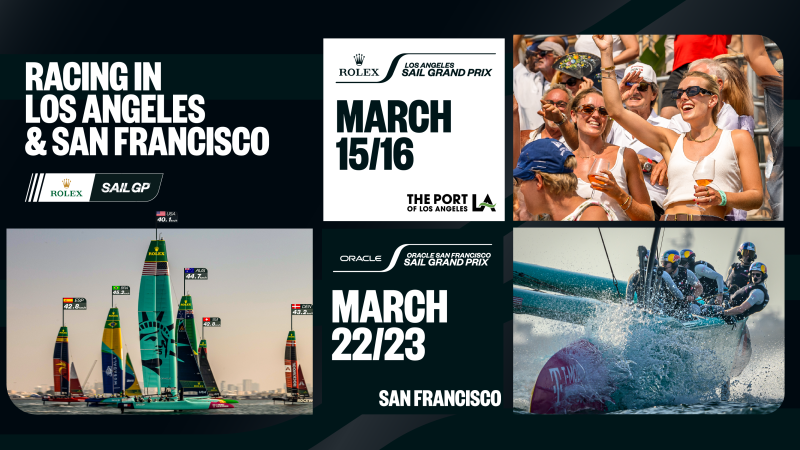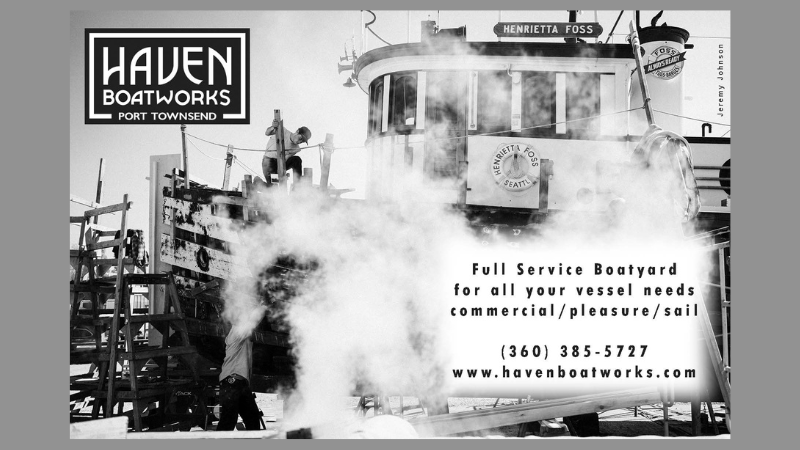
Winging It at SailGP in the Port of Los Angeles
SailGP landed in Southern California for a sunny, clear and cool weekend of hot foiling on the Port of Los Angeles waterfront. Saturday was the first time all 12 boats have hit the starting line, though Rockwool Denmark hit a mark with the new T-foils, thereby ending their weekend of racing. Taylor Canfield and Team USA were back in the game with middle-of-the-pack results ranging from fourth to 10th, finishing the weekend in ninth place. It was a sold-out crowd of 6,000 who watched the flat-water, close-quarters racing inside L.A. Harbor.
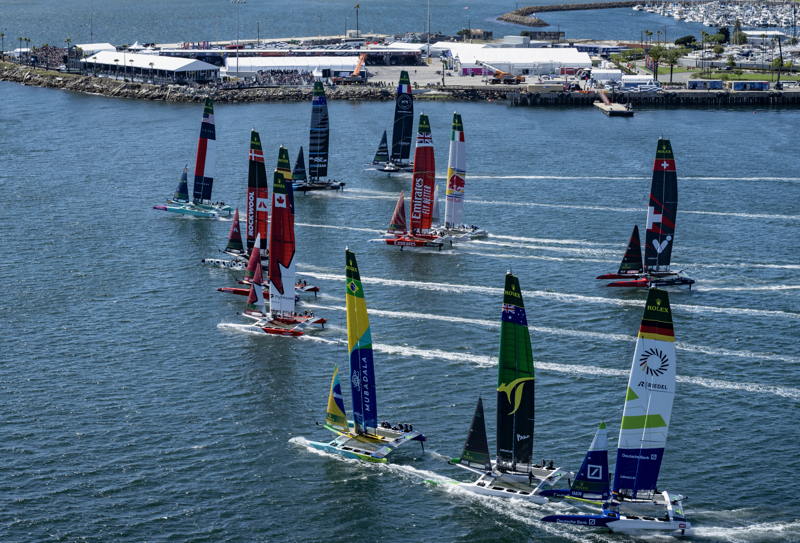
Saturday was the breezier of the two days, allowing solid foiling for the four fleet races. Sunday turned lighter, making it tough to stay in the air. After four fleet races on Saturday it was New Zealand on top, followed by Australia and Canada. The US ended the day in seventh place overall.
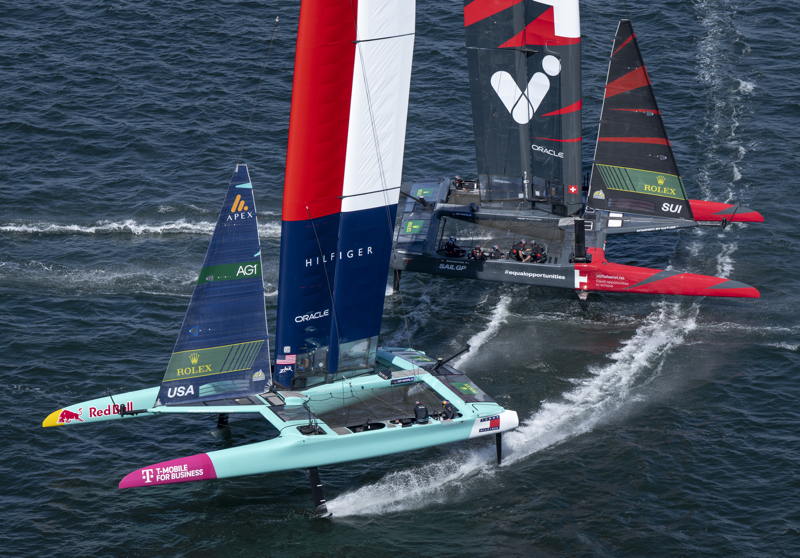
Latitude 38 Good Jibes host Ryan Foland was on hand for Saturday’s action, describing an energized scene of close action and patriotic fans. “This past weekend, I had the chance to experience SailGP in Los Angeles from a whole new perspective. As a sailor who hasn’t actively followed SailGP, I’ve always been intrigued by the spectacle of 50-ft foiling catamarans ripping across the water on foils at multiple times the speed of the wind. Last year, I watched from a boat, but this time — thanks to my media pass for Good Jibes — I was fully immersed in the energy of the crowd, rubbing elbows with pro sailors and diehard fans.”
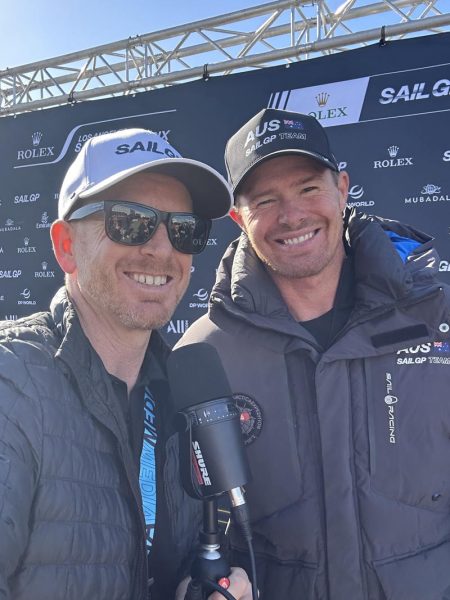
“From the moment I arrived, the enthusiasm was palpable. The grandstands were packed with a mix of salty sea dogs, young families, and curious first-timers. I met Angelenos who had never set foot on a sailboat, a couple from Tennessee who used the race as an excuse for a California getaway, and yacht club members proudly repping their burgee on hats and shirts. And, of course, I was handing out Latitude38 magazines like hotcakes.”
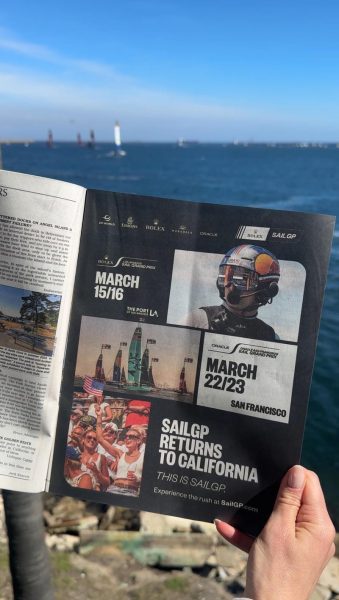
Ryan also noted, “One of the most striking aspects of the event was the national pride on display as well as how close the action was to the grandstands,” saying the big-screen TVs and live commentary were crucial. “After two SailGP events under my belt, I’m starting to get the hang of how the format works …,” he added, “and I have to admit, I’m hooked.”
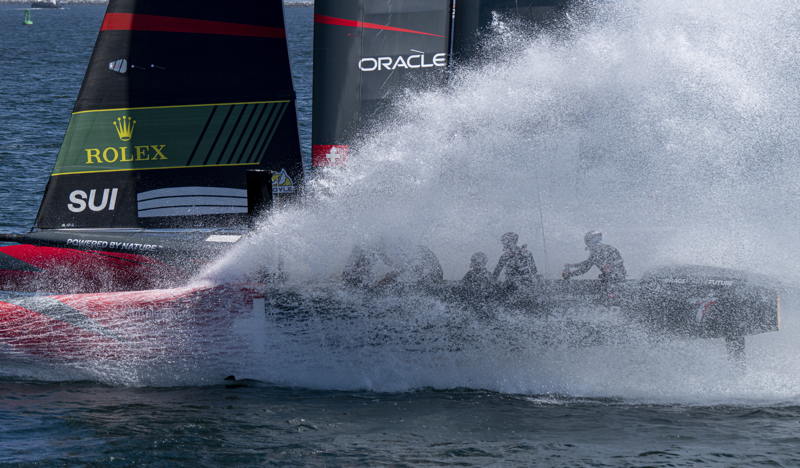
The light air on Sunday made it a battle to see who could stay up on their foils. If you were up you were winning, but dropping down was the kiss of death. The tight quarters force maneuvers that slow the boats, making it harder to foil, but the boats, all with just four crew aboard, managed to keep the racing competitive and shake up the standings.
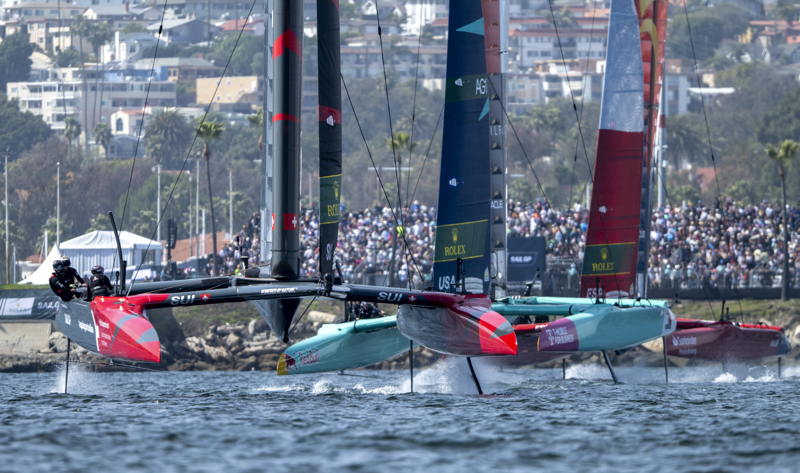
After the three-boat final race on Sunday, Giles Scott and Canada got their first weekend win of the season, followed by New Zealand and Australia. Emirates GBR took fourth for the weekend, maintaining their position at the top of the season-championship scoreboard, followed closely by Australia and New Zealand.
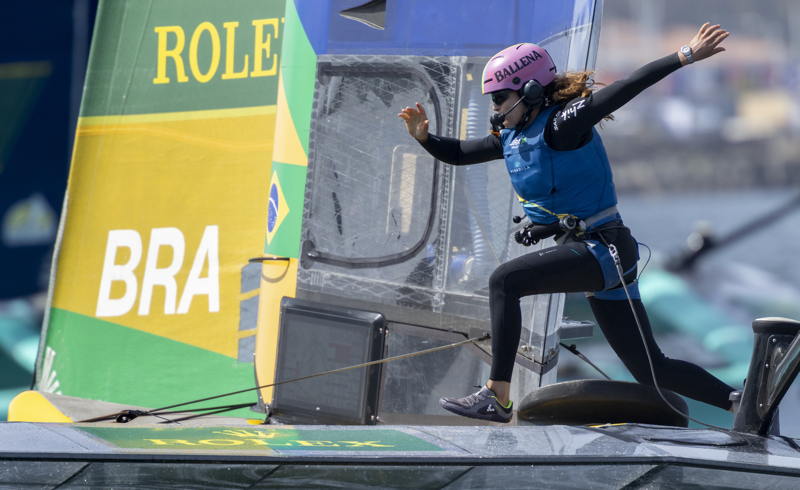
Today the SailGP shore team is packing quickly to shift the whole show north to San Francisco for the next event this coming weekend. Conditions on the Cityfront look solid enough for some good racing and a chance for Team USA to move it up another notch. Grab your grandstand tickets here.
Leg One of McIntyre Mini Globe Race Concludes in Panama
Naysayers be damned. A fleet of 15 19-ft mostly homebuilt, plywood ocean racers have completed Leg One of the Mini Globe race from Antigua to Panama. Fourteen of the 15-boat fleet departed Antigua on February 23 for the 1200-mile downwind leg to Panama. Amazingly, these little boats averaged over 100 miles per day, with the winner, Renaud Stitelmann, finishing in 8 days and 18 hours. All boats finished in under 12 days, with the top day’s run being 160 miles! While it’s a friendly competition, the first four boats finished within 10 hours of one another.

The last-place boat, Question 2, was arriving late in Antigua due to shipping delays and a qualifying sail, but as we write, it’s now just 12 miles from the finish line, bringing the whole fleet together in Panama. The 14 boats that started on the 23rd left Antigua in perfect 15-knot trade-wind conditions, which carried them quickly across the Caribbean to Panama. The leg was mostly drama free without any major gear failures, though sargasso weed slowed the boats down. Skipper Jasmine Harrison (the youngest competitor) on Nombatou reported the common challenge of clearing the weed collection off her rudder. In another incident, Dan Turk on Little Bea had a close encounter with what could have been a small whale, bringing his boat to a sudden halt from 6 knots and sending him flying into the galley bulkhead.
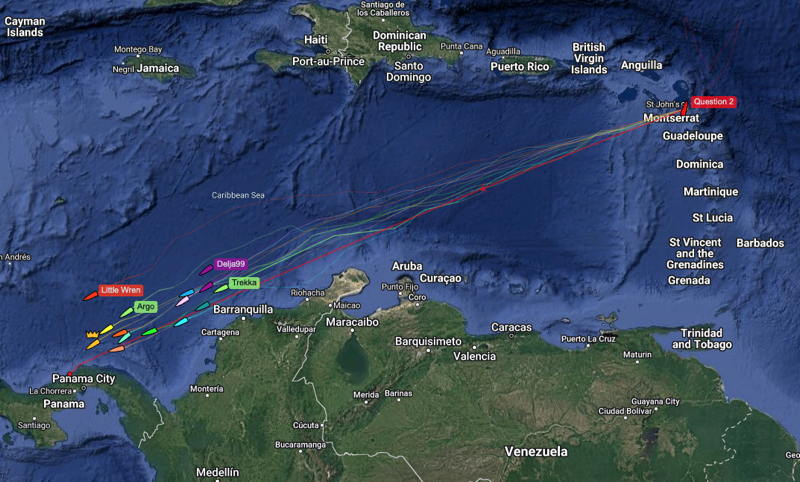
The boats also face strong adverse currents, especially near Colombia, where the wind against current kicked up tumultuous seas, keeping everyone alert aboard their small vessels. Staying out of the sun and weather meant staying below in a very warm, small cabin.

We caught up with the only American in the fleet, former mountain climber and now West Coast sailor Josh Kali, while he was resting up in Panama. In his typical upbeat manner he reported a great first leg, which started only six days after the completion of his qualifying sail from North Carolina to the starting line in Antigua. When asked how his boat, Skookum, performed, he said, “The boat’s in great shape, I just needed to wash the salt off; it’s really me that needs the rest.” Since his leg from North Carolina to Antigua was all upwind, the race from Antigua to Panama was the first time he sailed his boat downwind with spinnakers and rigging the poles, etc. It turned out to be a perfect shakedown sail.
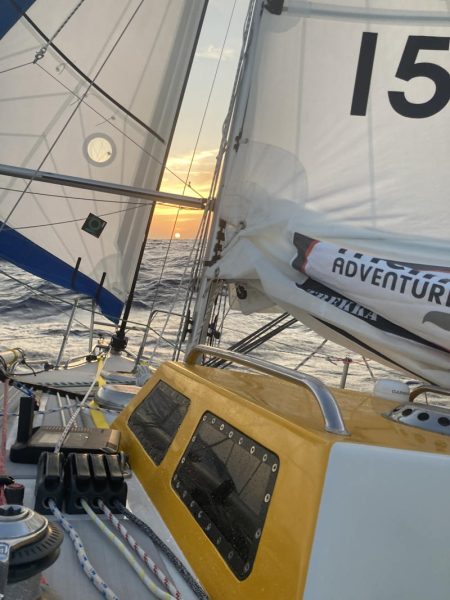
Josh reports that most boats made it without too much gear failure, but while they’re all gathered in Colón, the group is collectively working on whatever issues need to be resolved on each of the boats. Many of the competitors had met in advance of the start as they raced from the Cape Verde Islands to Antigua for their qualifying run. Josh caught up with them for his six days in Antigua before the start and is now connecting again in Panama. The skippers had shared information online while building and outfitting their boats in advance of the race, but the brief shore time together has demonstrated the kindred spirit among the 15 sailors (crazies?) who want to race around the world together for 400 days on 19-ft boats.
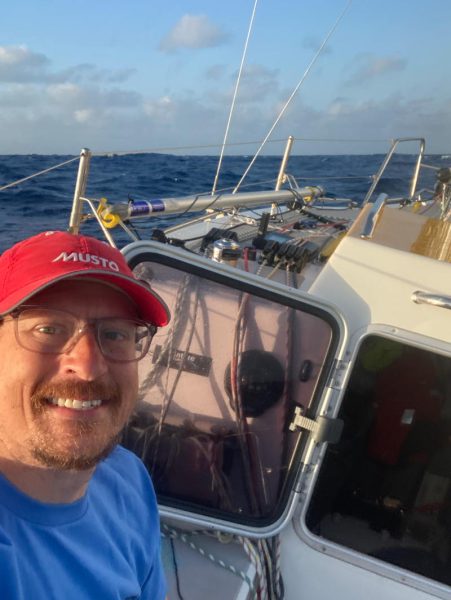
Josh says the next challenge in the event is crossing Panama. Because of the small size of the vessels, they are not using the canal but are crossing overland on trailers. This requires dropping the spars and rerigging on the other side. The goal is to hit the starting line for Leg Two to Fiji (with required stops in the Marquesas and Tonga) on March 23, though some trailering issues might delay the departure. For the sailors, the 50 miles across Panama on land may be more worrisome than crossing the open ocean.
Josh now has the rhythm of sailing his boat downwind and is looking forward to the next approximately 40-50-day leg across the Pacific to the Marquesas. You can hear more from Josh in our Good Jibes podcast with him while he was preparing for the race in North Carolina. Follow the Mini Globe Race here.
Grab Your Tickets for SailGP in San Francisco
SailGP, the world’s most exciting racing on water, returns to California this spring with back-to-back events:
-
Rolex Los Angeles Sail Grand Prix –– March 15-16
-
Oracle San Francisco Sail Grand Prix –– March 22-23
Experience two action-packed weekends as 12 national teams battle it out in high-speed, 50-foot foiling catamarans flying at over 60 mph.
With national pride, personal glory, and $12.8 million in prize money on the line, the stakes have never been higher for sailing’s top athletes. Don’t miss your chance to witness this epic, close-to-shore racing set against the iconic backdrops of the Port of LA in SoCal and the Golden Gate Bridge on the Bay.
Enjoy the ultimate day out by the water and get your tickets now!
World of Chartering: Cruising Tales From Croatia and Sweden
Thursday is the vernal equinox — the time we officially sail into spring. Spring leads to summer and hours and hours of warmer-weather sailing. For some, this means signing up for a full calendar of racing, while some prefer the gentle approach and look forward to lazy days cruising and anchoring on the Bay. Then there are those, like Club Nautique sailing instructor and charter captain Rod Witel, who plan their sailing adventures father afield. In Latitude’s March issue, we shared Rod Witel’s stories of taking part in a flotilla in Croatia, then cruising with friends in Sweden.
Club Nautique (CN), a S.F. Bay Area sailing/powerboating school and yacht charter company, sponsored a one-week Croatia flotilla for its members September 7–14, 2024.
For many of the 70+ participants, this was their first international charter, so CN provided pre-charter clinics for Med-mooring (with lazy lines) and to practice picking up mooring balls. Many of the crews arrived in Croatia early to sightsee the UNESCO World Heritage cities of Split, Trogir, and the “Jewel of the Adriatic,” Dubrovnik.
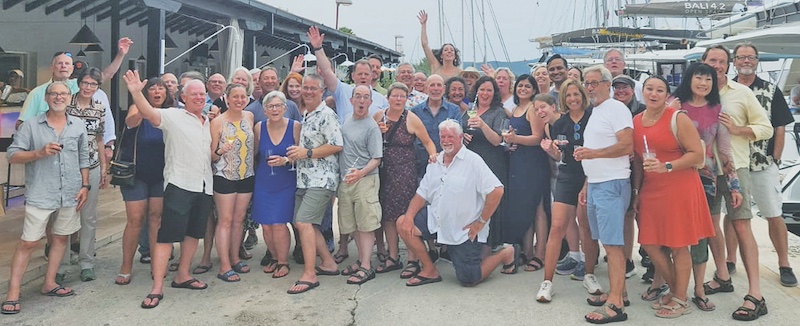
Our flotilla of 12 boats (four catamarans and eight monohulls) set off from the Baotic Marina in Trogir, where we provisioned for breakfasts and lunches. Dinners were onshore. We enjoyed daily lunch stops in idyllic bays to eat, relax, and swim in the warm blue water before sailing to our overnight destinations.
The highlights of the trip started at the quaint village of Milna, Braĉ, where we had a group dinner at Perun, a very accommodating and delicious quayside restaurant. The flotilla remained safely in Milna for a second day as a front brought high winds and big seas. Some chose a wine-tasting tour, confirming Croatia’s excellent viticulture reputation.
From the Pakleni Islands, we took water taxis (20 min./20 Euros p/p) to the famed Hvar, a fun, vibrant town with breathtaking sunset views from the historical Fortica Fortress high above the city.
Our longest sail (24 miles) brought us to the charming seaside village of Komiza on the island of Vis. The famous Blue Cave was closed due to a southern swell, but the crews enjoyed exercising on the town quay, eating yet more delicious gelato, swimming, shopping, and wine tasting, and some booked a military tour that included Tito’s Cold War submarine caves.
We ended with a giant raft-up in Sesula Bay on the island of Solta, and enjoyed a lazy afternoon swimming and relaxing behind the boats. Some walked to the nearby town of Maslinica for live folk music before everyone met up for a delicious dinner at Sismis Restaurant, which provided the mooring balls we rafted to.
My last Croatia charter was in 2011, a one-way charter from Split to Dubrovnik. Since then, Croatia has joined the EU and is much more expensive; it is inundated with American tourists in the summer and the marina fees are exorbitant. Yet it is a magical place to charter, with amazing history and architecture, warm blue water, and friendly people. Croatia should definitely be on your chartering bucket list.
California Coastal Commission Rejects Newport Beach Mooring Realignment
After strong opposition from the community of boaters, the California Coastal Commission voted to deny the City of Newport Beach’s proposal to realign the mooring fields and replace existing moorings with helix anchors. The decision, voted upon on February 5, has pleased the local mooring holders, 50 of whom had gathered at the meeting to share their concerns about the city’s proposal — they cited issues including “safety, inequity, conflict of interest, and environmental justice,” The Log reports.
While we’re facing similar issues regarding the docks and mooring arrangements in Ayala Cove, the Newport Beach mooring field in question covers a much larger area and is home to a number of authorized liveaboards. The city wants to transition from the traditional moorings to helix anchors, claiming their intention is to improve navigability, though Newport Beach Mooring Association president Anne Stenton remains uncertain about “the true intent,” The Log writes.
One of the issues, Stenton claims, is the city’s lack of community engagement in making their proposal for the mooring realignment. The Log writes that some speculate the motivation stems from homeowners’ desire for a “more aesthetically pleasing and structured view of the mooring fields, resembling an orderly parking lot.” This, however, is not confirmed.
The proposed changes were first announced in 2018. “Evaluate the current mooring fields and provide a recommendation for new guidelines that better define rows and fairways to improve navigation, safety, and optimization of space within the mooring fields,” the proposal begins. It also adds, “We plan to solicit additional expert opinion on the proposal.” Stenton told The Log that while there had been collaboration between the city and the mooring association for over 50 years, the past eight years have seen a decline in such collaborations. ““Many experienced mariners, including licensed captains who hold mooring permits, feel their expertise has been overlooked,” Stenton told The Log.
While the California Coastal Commission’s decision is a reprieve for those who would be affected, and the city suggests there are currently no alternative plans to alter the mooring situation, some mooring permit holders and liveaboards remain concerned. Community member and liveaboard Samantha McDonald told The Log, “The main issue with the double-row configuration [outlined in the city’s proposal] is that mariners lose an important approach direction to their mooring, which is critical during adverse weather conditions.”
We are happy the boating community has had this win, but we are all too aware of how fickle these decisions can be over the longer term. Maintaining and strengthening the boating community are important factors in preserving the lifestyle we all love.
Read the full story here.

